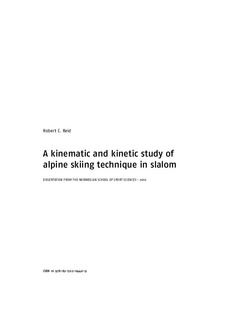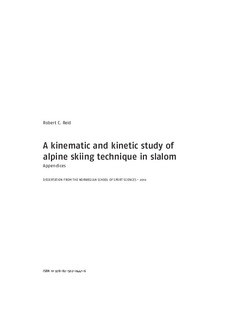| dc.description.abstract | Despite a large body of lay and professional literature covering numerous aspects of
alpine skiing technique, only a limited number of published scientific investigations
have examined the relationship between skier technical and tactical characteristics and
racing performance. As a consequence, our scientific understanding of how the
underlying mechanics of alpine ski racing technique relate to performance is
surprisingly weak. The purpose of this research project was therefore to identify,
describe, and study aspects of alpine ski racing technique which play an important role
in determining skier performance. Since this is the first project of its kind for our
research group, an additional purpose was to establish the theoretical and
methodological foundation for a line of future research on this topic.
Initially, a conceptual model of turning technique was developed to provide the
theoretical framework for defining research questions. This model was built on the
basis of a literature review and 17 in-depth interviews with highly-experienced coaches
from 6 nations. Research questions were then defined on the basis of this model for a
quantitative, motion analysis study of turning technique, the purpose of which was to
quantitatively describe the various components of the aforementioned model and to
explore their interrelationships with the ultimate aim of further developing our
understanding of how turning mechanics relate to racing performance.
Towards this end, a 3-dimensional, video-based photogrammetric method utilizing
multiple panning cameras was implemented to capture the performances of six highly skilled
athletes during slalom race simulations on courses with 10 and 13 m linear gate
distances. The resulting data were then used to examine kinematic, kinetic, and
energetic questions related to ski motion, skier technique, and performance. A
comparison between courses was made in the hope that understanding how skiers
adapted to the differing circumstances would shed further light on the relationship between turning mechanics and performance. This dissertation describes in detail the
methods and results of this investigation.
In terms of ski motion, the results of this investigation provide observational evidence
in support of current theoretical models of ski snow interaction mechanics and may
provide insight into both ski design and injury prevention issues. Many of the
differences observed between courses in terms of ski motion, skier kinematics and skier
kinetics seem to be reminiscent of differences between carving and skidding
mechanics, which is perhaps not surprising considering that there was a greater degree
of carving on the 13 m course.
Perhaps a finding of particular significance was the difference in turn cycle structure
observed between courses. While the skiers’ trajectories were symmetrically distributed
about the gate on the 10 m course, there was a prolonged Initiation Phase on the 13 m
course, resulting in an asymmetrical trajectory about the gate. This difference in turn
structure and trajectory shape may to a large degree be the result of the different gate
distances and the skis’ physical properties. Further work to understand why this
difference occurred may help to improve our understanding of how ski characteristics
influence turn mechanics.
In terms of kinetics, maximal snow reaction forces were high, reaching over 3000 N and
3.5 times bodyweight on both courses. There was a clear difference in the timing of the
snow reaction force relative to the turn cycle between courses. On the 10 m course,
large reaction forces were generated at about 50 % of the turn cycle, or approximately
gate passage. In contrast, peak forces were delayed on the 13 m course, occurring just
after gate passage, or about 65 % of the turn cycle. In addition, there was a greater
degree of unloading in the vertical component of the snow reaction force during the
Initiation Phase on the 13 m course. The air drag force was larger on the 13 m course
due to increased skier speeds. Mechanical energy dissipation, introduced by Supej, Kugovnic, and Nemec (2005a),
was calculated based on skier center of mass motion. A cyclical pattern of energy
dissipation was observed on both courses with high dissipations occurring during the
turn and low dissipations during the transition between turns. Negative dissipations—
situations where skier kinetic energy increased by more than what can be attributed to
changes in skier potential energy—were observed at the transition between turns on
the 10 m course and early in the turn cycle on the 13 m course. This may provide
evidence of skiers increasing their kinetic energy through muscular work, although in
this study these increases were small, representing less than 3 % of skier kinetic energy
gains.
To help understand what factors acted to slow the skier, the negative work of each of
the external forces acting on the skier was calculated. About 20 % of skier total
mechanical energy loss in the investigated situation was due to air drag. The remaining
majority of mechanical energy losses were attributed to a drag component of the snow
reaction force. However, this study does provide evidence suggesting that the energy
cost of gate clearance in slalom may play a significant role and needs to be accounted
for in future work.
In terms of racing performance, both skier vertical and fore/aft actions correlated well
with elapsed time through the investigated sequence. The relatively strong correlation
observed between skier fore/aft position and mechanical energy loss further indicates
that this is a parameter whose role in skiing mechanics and performance should be
investigated further.
In summary, this project has provided a conceptual model of turning technique in
alpine ski racing that is based on both scientific and practitioner knowledge and that
can be used to guide future research efforts. The results of this investigation are limited
in that generalization from a single situation, and a single group of athletes, to other
circumstances needs to be considered very carefully, particularly in light of the infinitely variable conditions possible in alpine ski racing. Moreover, the observational
design of this study does not provide evidence of cause and effect relationships. In
light of these limitations, perhaps the most important scientific contribution of this
study lies in the identification of turning technique parameters which need to be better
understood to further develop our knowledge of how the mechanics of turning
technique relates to performance. Perhaps of particular importance in future work will
be the development of our understanding of how skier actions influence the ski snow
interaction and, ultimately, ski and skier motion. | no_NO |

